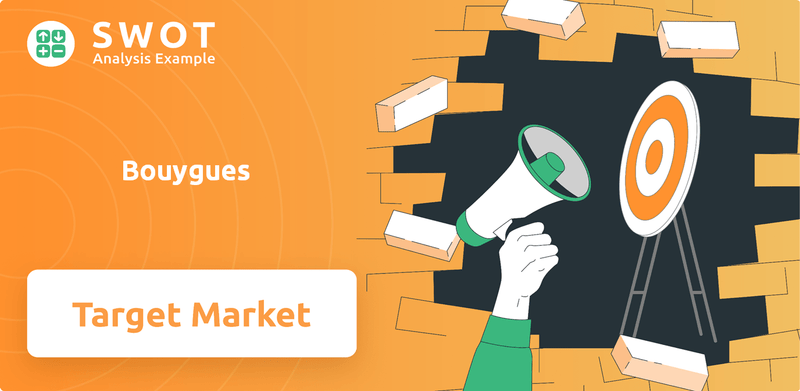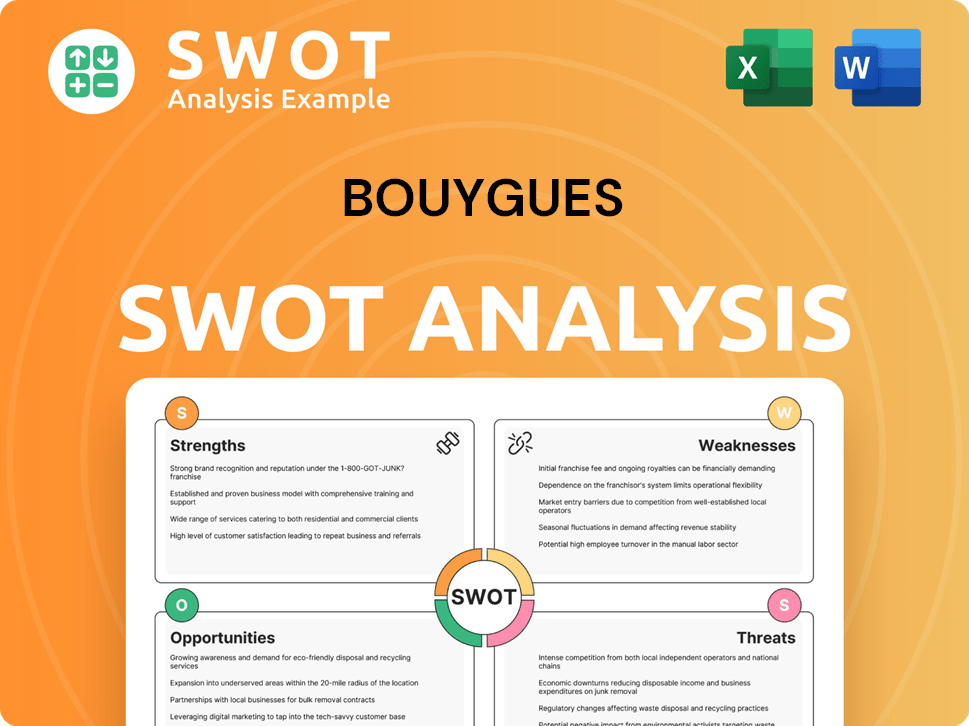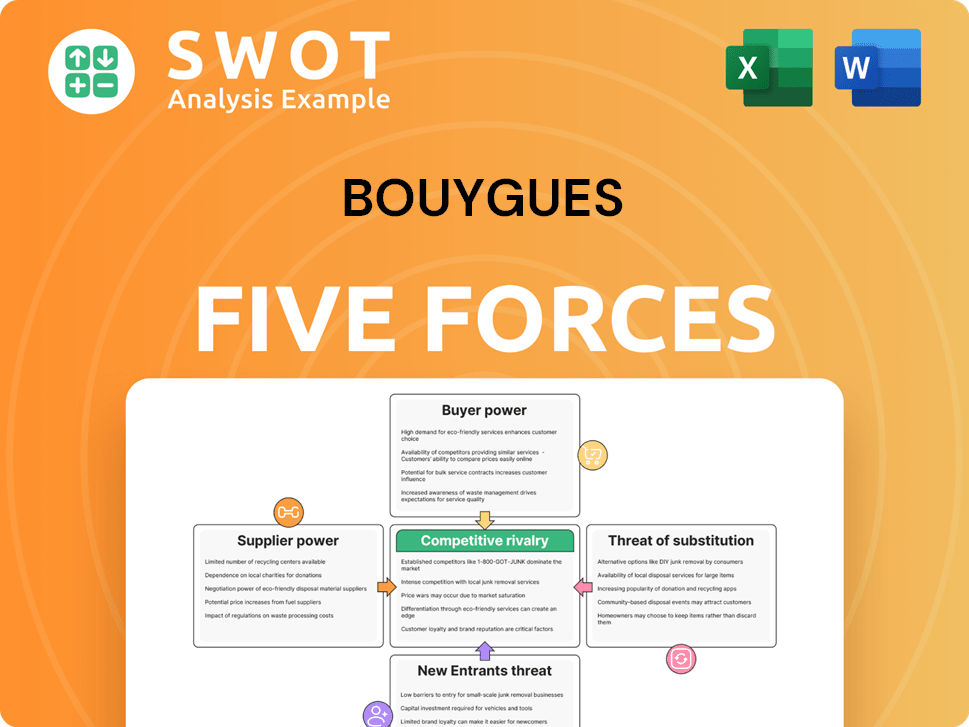Bouygues Bundle
How Well Does Bouygues Know Its Customers?
In the ever-evolving landscape of business, understanding your customer is key to survival. For a giant like Bouygues, a deep dive into its Bouygues SWOT Analysis reveals the critical importance of knowing its customer demographics and target market. This knowledge is essential for Bouygues, a company with diverse offerings, to stay ahead of the curve.

This exploration into Bouygues's customer base will illuminate the strategies behind its success. We'll dissect the company's approach to market analysis, examining the consumer profile across its various sectors, including Bouygues Telecom. By analyzing the specific needs and preferences of its diverse clientele, we can understand how Bouygues strategically adapts its services to maintain and grow its market position.
Who Are Bouygues’s Main Customers?
Understanding the customer demographics and target market of Bouygues is crucial for assessing its business performance. Bouygues operates across diverse sectors, including telecommunications, construction, and media, each with distinct customer segments. A comprehensive market analysis reveals the company's strategic focus on both consumer (B2C) and business (B2B) clients.
Bouygues' approach to its target market varies significantly across its business units. Bouygues Telecom concentrates on B2C customers, providing mobile and fixed-line services. Meanwhile, its construction and energy divisions primarily serve B2B clients, offering infrastructure, building, and energy solutions. This dual approach allows Bouygues to capture a broad market, catering to both individual consumers and large corporations.
The company's ability to adapt its services to meet the needs of different customer segments is key to its success. For example, Bouygues Telecom has shifted its strategy to prioritize fixed services to cater to households. This shift is driven by heightened customer concerns about the cost of living. The acquisition of La Poste Telecom is a strategic move to broaden their mobile subscriber base, appealing to a wider demographic.
Bouygues Telecom primarily targets individual consumers. By the end of December 2024, it had a mobile plan customer base (excluding machine-to-machine) of 18.3 million. The acquisition of La Poste Telecom added 2.4 million customers. The fixed customer base reached 5.2 million by the end of 2024, with 4.2 million FTTH customers.
Bouygues Construction, Colas, and Bouygues Immobilier mainly serve business clients. Bouygues Construction's backlog at the end of 2024 was €18.2 billion. Equans, the energy and services arm, also focuses on B2B customers, providing solutions for energy, industrial, and digital transitions.
TF1, the media segment, targets a broad B2C audience. In 2024, TF1 had an audience share of 33.5% in the WPDM 50 category and 30.5% among individuals aged 25-49.
Bouygues is adapting to market changes, such as the residential property market in France, where sales from residential property were down 14% year-on-year in 2024. The company's focus on fixed services reflects a response to customer needs. For more insights into Bouygues' overall strategy, consider reading about the Growth Strategy of Bouygues.
Bouygues' customer demographics are diverse, spanning across consumer and business sectors. The company's target market is segmented by business units, with Bouygues Telecom focusing on B2C and construction/energy divisions on B2B. This strategy allows for a broad market reach and adaptability to changing customer needs.
- Bouygues Telecom: Primarily B2C, offering mobile and fixed-line services.
- Construction Businesses: Primarily B2B, serving public and private clients.
- Equans: B2B, providing energy and digital transition solutions.
- TF1: B2C, targeting a broad audience through television and radio.
Bouygues SWOT Analysis
- Complete SWOT Breakdown
- Fully Customizable
- Editable in Excel & Word
- Professional Formatting
- Investor-Ready Format

What Do Bouygues’s Customers Want?
Understanding the diverse customer needs and preferences is crucial for the success of any company, and for Bouygues, this understanding is particularly complex due to its varied business segments. The company's approach to meeting these needs varies significantly across its telecommunications, construction, and real estate divisions. This targeted approach allows Bouygues to tailor its offerings and strategies to specific customer segments, ensuring relevance and competitiveness in each market.
For Bouygues Telecom, customer needs revolve around reliable connectivity, competitive pricing, and comprehensive service packages. In the construction and services sectors, the focus shifts to reliability, expertise, and cost-effectiveness, with an increasing emphasis on sustainable solutions. Bouygues Immobilier, on the other hand, focuses on designing living spaces that reflect user needs, indicating a preference for tailored property solutions.
The company's ability to adapt to these varied demands is reflected in its strategic initiatives and performance. For example, Bouygues Telecom's investment in FTTH infrastructure and the launch of new offers demonstrate a commitment to meeting customer demands for high-speed internet and attractive bundles. Similarly, Bouygues Construction's focus on sustainable construction addresses the growing client preference for environmentally responsible solutions.
Bouygues Telecom customers prioritize high-quality networks, competitive pricing, and comprehensive service bundles. The demand for reliable and fast internet is evident in the company's focus on FTTH expansion. Furthermore, customer support and personalized service are enhanced through AI integration.
B2B clients in construction and services value reliability, expertise, cost-effectiveness, and sustainability. Bouygues Construction focuses on sustainable construction and innovation. Equans provides comprehensive services addressing major societal challenges like energy and digital transitions.
Bouygues Immobilier focuses on designing living spaces that reflect user needs. This indicates a preference for tailored property solutions in the residential market. The company adapts to changing market conditions to meet customer expectations.
Bouygues Telecom aims to market 38 million FTTH premises by the end of 2024, with a target of 40 million by the end of 2026. This expansion directly addresses the customer need for widespread, high-speed internet access. The company's investment in FTTH underscores its commitment to meeting customer demands for reliable and fast internet.
The launch of new offers like B.iG and B&YOU Pure Fibre in late 2024 is designed to attract new customers and encourage multi-line households. These offers are tailored to address cost-of-living concerns and provide attractive bundles. Bouygues Telecom's strategic moves aim to capture a larger customer base.
The consistently high backlog in construction businesses, reaching a record €32.2 billion at the end of 2024, demonstrates strong demand. This backlog underscores the ongoing demand for Bouygues Construction's services. The robust backlog reflects the company's ability to secure and manage significant projects.
Bouygues employs customer-centric strategies across its business segments. For Bouygues Telecom, this involves network upgrades, competitive pricing, and AI-enhanced customer service. In construction and services, the focus is on reliability, expertise, and sustainable solutions. Bouygues Immobilier tailors its offerings to meet the specific needs of its clients.
- Bouygues Telecom: Prioritizes high-quality networks, competitive pricing, and comprehensive service bundles.
- Construction and Services: Focuses on reliability, expertise, cost-effectiveness, and sustainable solutions.
- Bouygues Immobilier: Designs living spaces reflecting user needs, indicating a preference for tailored property solutions.
- Strategic Acquisitions: The acquisition of La Poste Telecom enhances market reach and competitiveness.
- AI Integration: AI is integrated into the CRM platform to enhance customer experience.
For a deeper understanding of how Bouygues generates revenue and structures its business, consider exploring the Revenue Streams & Business Model of Bouygues.
Bouygues PESTLE Analysis
- Covers All 6 PESTLE Categories
- No Research Needed – Save Hours of Work
- Built by Experts, Trusted by Consultants
- Instant Download, Ready to Use
- 100% Editable, Fully Customizable

Where does Bouygues operate?
The geographical market presence of Bouygues is extensive, spanning over 80 countries. This global reach is a key aspect of its operations, with varying concentrations across its different business segments. Understanding the distribution of its operations is crucial for a comprehensive market analysis of the company.
While the company's telecommunications and media interests are primarily focused in France, its construction, energy, and services sectors have a significant international footprint. This diversification across different regions reflects a strategic approach to mitigate risks and capitalize on opportunities in various markets. The company's expansion strategy involves a deep understanding of local markets.
The distribution of net sales for the Bouygues Group reveals a diverse geographical presence. France accounts for 48.7% of net sales, followed by the European Union at 15%. Other European countries contribute 14.8%, North America 12.3%, Asia/Pacific 5%, Africa 2.6%, Central and South America 1.1%, and the Middle East 0.5%. This diverse distribution highlights the need for tailored strategies for different customer demographics, preferences, and purchasing power across these regions. For more information about the company's overall strategy, you can read about the Growth Strategy of Bouygues.
Bouygues Telecom primarily operates within France, offering mobile and fixed-line services. The company is actively expanding its reach throughout France, including the rollout of FTTH premises. By the end of 2024, they reached 38 million marketed premises, with a target of around 40 million by the end of 2026.
Bouygues's construction businesses, including Bouygues Construction, Colas, and Bouygues Immobilier, have a more extensive international presence. The international backlog for the construction businesses rose to approximately 68% of the total by the end of 2024, up from 63% in 2021. This growth is primarily driven by Bouygues Construction.
Bouygues Construction secured major projects in 2024, including the Melbourne metro tunnels in Australia and a campus in Bern, Switzerland. Colas has a strong presence in North America, partly due to the acquisition of Miller McAsphalt in Canada in 2018. These projects highlight the company's global reach and diverse customer base.
The geographical distribution of net sales demonstrates the company's diverse market presence. France accounts for the largest share at 48.7%. The European Union contributes 15%, other European countries 14.8%, and North America 12.3%. These figures highlight the importance of understanding the customer demographics in each region.
Bouygues Business Model Canvas
- Complete 9-Block Business Model Canvas
- Effortlessly Communicate Your Business Strategy
- Investor-Ready BMC Format
- 100% Editable and Customizable
- Clear and Structured Layout

How Does Bouygues Win & Keep Customers?
Bouygues employs a multifaceted strategy for customer acquisition and retention, tailored to its diverse business segments. This approach combines traditional and digital channels, strategic partnerships, and service enhancements. The company focuses on understanding the specific needs of its customer demographics across different sectors, from telecommunications to construction and services.
In the telecommunications sector, Bouygues Telecom prioritizes competitive pricing and attractive bundles to acquire new customers. For its construction and services businesses, the focus is on securing large-scale B2B projects through tenders and building strong, long-term relationships. The company also leverages data analysis to refine its strategies and improve customer experience across the board.
Bouygues's commitment to innovation and sustainability plays a crucial role in both attracting and retaining customers. This includes initiatives like integrating AI in customer relationship management and offering decarbonization solutions for clients. A deeper dive into the Marketing Strategy of Bouygues reveals how these strategies are implemented across the organization.
Bouygues Telecom focuses on offering competitive pricing and attractive bundles to acquire new customers. The company emphasizes fixed services, with 615,000 new FTTH customers added in 2024, bringing the total to 4.2 million. The acquisition of La Poste Telecom in late 2024 added 2.4 million mobile customers.
Customer acquisition in construction and services (Bouygues Construction, Colas, Equans) is driven by tender processes and reputation. The construction sector held a record €32.2 billion backlog at the end of 2024, with 68% from international projects. This underscores the success in securing major contracts.
Bouygues Telecom integrates AI into its CRM platform, using the Be360+ augmented console for enhanced customer inquiry resolution. Gamified referral programs and personalized rewards foster loyalty and community engagement, as seen with the 'Source' initiative. These efforts aim to improve Bouygues Telecom customer satisfaction.
Retention in construction and services relies on consistent project delivery, adherence to budgets, and sustainability credentials. Equans' 'Carbon Shift' initiative, offering decarbonization solutions, attracts and retains clients focused on low-carbon transitions. This approach caters to a specific target market.
Bouygues continuously analyzes market trends and financial performance to adapt its strategies. This data-driven approach ensures that the company remains responsive to changes in customer demographics and market demands. This supports effective Bouygues target market segmentation.
Bouygues's overall strategy includes diversification and investment in innovation to enhance efficiency and customer experience. These efforts contribute to both customer acquisition and retention across all business segments. This helps to define who is Bouygues' ideal customer.
Bouygues Telecom uses a portfolio of brands, including B.iG and B&YOU, to reach various market segments. This multi-brand strategy allows the company to cater to different Bouygues customer age range and preferences. This enhances Bouygues customer behavior analysis.
Equans' 'Carbon Shift' initiative is a key example of how Bouygues addresses sustainability. This approach attracts clients focused on low-carbon transitions, which is increasingly important in today's market. This can influence Bouygues customer needs and wants.
The integration of AI in CRM and the use of the Be360+ console are designed to improve customer inquiry resolution. These technologies aim to enhance the overall customer experience. This can impact Bouygues customer lifetime value.
The acquisition of La Poste Telecom adds 2.4 million mobile customers, with plans to migrate them to Bouygues Telecom's network. This strategic move expands Bouygues' customer base significantly. This affects Bouygues market share by customer segment.
Bouygues Porter's Five Forces Analysis
- Covers All 5 Competitive Forces in Detail
- Structured for Consultants, Students, and Founders
- 100% Editable in Microsoft Word & Excel
- Instant Digital Download – Use Immediately
- Compatible with Mac & PC – Fully Unlocked

Related Blogs
- What are Mission Vision & Core Values of Bouygues Company?
- What is Competitive Landscape of Bouygues Company?
- What is Growth Strategy and Future Prospects of Bouygues Company?
- How Does Bouygues Company Work?
- What is Sales and Marketing Strategy of Bouygues Company?
- What is Brief History of Bouygues Company?
- Who Owns Bouygues Company?
Disclaimer
All information, articles, and product details provided on this website are for general informational and educational purposes only. We do not claim any ownership over, nor do we intend to infringe upon, any trademarks, copyrights, logos, brand names, or other intellectual property mentioned or depicted on this site. Such intellectual property remains the property of its respective owners, and any references here are made solely for identification or informational purposes, without implying any affiliation, endorsement, or partnership.
We make no representations or warranties, express or implied, regarding the accuracy, completeness, or suitability of any content or products presented. Nothing on this website should be construed as legal, tax, investment, financial, medical, or other professional advice. In addition, no part of this site—including articles or product references—constitutes a solicitation, recommendation, endorsement, advertisement, or offer to buy or sell any securities, franchises, or other financial instruments, particularly in jurisdictions where such activity would be unlawful.
All content is of a general nature and may not address the specific circumstances of any individual or entity. It is not a substitute for professional advice or services. Any actions you take based on the information provided here are strictly at your own risk. You accept full responsibility for any decisions or outcomes arising from your use of this website and agree to release us from any liability in connection with your use of, or reliance upon, the content or products found herein.